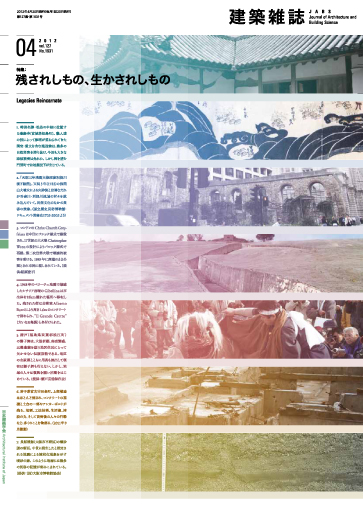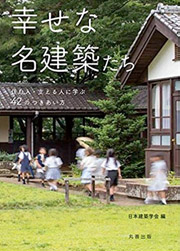本文PDFの閲覧につきましては、こちらでご確認ください。

2012-4月号 APRIL
特集= 残されしもの、生かされしもの
Legacies Reincarnate
特集前言 地域文脈の地層へ
「何もかも流されてしまった」というのは、当初は多くの人にとって偽らざる印象だったろう。阪神・淡路大震災と比べてみればわかるように、東日本大震災の顕著な特徴のひとつは、たしかに歴史的に培われた地域景観の極端な断絶ということになるかもしれない。いわゆる高所移転をはじめとする今後の復興計画も、この断絶をさらに深める可能性が高い。そして、それゆえにこそ、残されたものに向かう感受性や洞察力は鋭く研ぎすまされる。被災地には、実は多くのものが残されている。
本特集は、被災地に残る、もの言わぬものたちの声を聞くことをテーマとした。それは私たちの耳のありようを問い直すことでもある。
第1部は「残されし文化財」と題し、社会的に認知された「文化財」の「残されし」姿からメッセージを引き出す。最初の座談会では、文化財が蔵している防災上の教訓をめぐって、埋蔵物や民俗伝承にまで視野を広げ、高橋学(環境考古学)、佐野賢治(民俗学)、西和夫(建築史学)の三氏に議論していただいた。
つづけて、大和智、藤川昌樹、永井康雄、武藤正幸、花里利一、上野勝久の諸氏に、文化庁や本会をはじめとする諸団体による文化財建造物の被災調査や応急対策等の取組みを振り返りつつ、被害の特質・背景・制度などについて報告していただいた。広域被害ゆえに支援体制の限界が浮かび上がったこと、国宝・重文に深刻な構造的被害が少ない一方、登録文化財等は近代以降に海岸線付近に建てられたものが多く全壊もかなりの数になること、財政上の理由などから災後に取り壊された歴史的建造物も少なくないことなどが指摘されている。印象的なのは、自然災害による被害の背景に、むしろ平時における維持・修理の問題、何よりも地域社会そのものの持続可能性の問題があるという指摘である。
小谷竜介、今西純一、稲田孝司、橋本裕之の各氏には、関連して、動産(資料や美術作品等)の応急処置、海岸林・屋敷林などにみる自然と社会とのかかわり方の文化、復興事業の背後で進められる埋蔵文化財発掘調査、地域再建における祭の役割などについて論じていただいている。
第2部「生かされし有象無象」では、文化財行政の外側に遍在する、アノニマスな建造物あるいは瓦礫や痕跡といったものたちのメッセージをも聞き取っていく。
まず、中谷礼仁、頴原澄子の両氏の対談では、「保存」という意識がどのように生じ、そして社会がモノを再び位置付け直してゆく様態にはどのようなものがあるかが議論されている。廃墟が日常的なアメニティへと転ずる回路、そして無意識的な残存が将来の社会的承認への架橋たりえる可能性など、重要な指摘がある。
つづく記事では、耐震工学の専門家として被災地を見てこられた薛松濤氏、魚介類の生態から漁場整備に携わる伊藤靖氏、過去や記憶への特異なスタンスで知られる建築家の宮本佳明氏(脇坂圭一氏による取材)が、それぞれの知識・技術・倫理から、被害を受けた構造物や痕跡の声を聞こうとする姿が伝わる。液状化で傾いた家屋を解体せず動かして修正する技術と職能に関する石榑督和のレポート、残された土地をめぐる諸関係が次なる都市や集落へと変換される道筋を広く展望する松本裕氏の論考も、ありうべき議論の厚みを感じさせる。
こうして、地域の文脈は、国家から村までの共同体による認知と継承、そして広い意味での技術知の専門性に応じていくつもの姿で切り出されるが、さらにわれわれの意識が届かない潜在的な層があって、全体としては時間と意識が織り成す複雑な地層のごときありようをしているのではないかと思われてくる。
むすびの座談会は、それらを具体的な都市や集落という環境のまとまりのなかでどのように人の生活や生業、社会システムとともに読み取り、再び織りなしていけるのかを描き出す試みである。中津秀之(ランドスケープ)、三浦卓也(まちづくりコンサルタント)、櫻井一弥(建築設計)の三氏が地域再建の現場に根ざしつつ切実な問いを投げかけている。
会誌編集委員会
本号編集担当:梅津章子(文化庁)・大沼正寛(東北工業大学)
[目次]
| 000 | 連載 再建への意志:図面のなかの都市復興 渋谷戦災復興計画案─池辺陽/金子祐介 |
| 002 | 連載 東日本大震災|連続ルポ1|動き出す被災地 復興のバージョンアップ─ISHINOMAKI 2.0の試み/西田司 + 小泉瑛一 |
| 004 | 連載 東日本大震災|連続ルポ2|仮すまいの姿 避難所になった公共ホール/新田満 |
特集 残されしもの、生かされしもの
| 006 | 特集前言 地域文脈の地層へ |
第1部 残されし文化財
| 008 | 座談会 残されし災害の記録に学ぶ 佐野賢治 × 高橋学 × 西和夫 |
| 013 | 過去の災害情報を受け継ぐ文化財/大和智 |
| 014 | 地域の文化財建造物にゆっくりと迫る危機/藤川昌樹 |
| 016 | 東日本大震災復旧・復興に向けての官民協働活動─文化財ドクター派遣事業/永井康雄 |
| 017 | 被災した文化財建造物に対する修復理念/武藤正幸 |
| 018 | 「残されし歴史的建造物」の構造修復に向けて/花里利一 |
| 020 | 失われた文化財 その問題点/上野勝久 |
| 021 | 文化財レスキュー事業と文化財の救済/小谷竜介 |
| 022 | 用と美を兼ね備えた景観─白砂青松の海岸林と平野の屋敷林/今西純一 |
| 024 | 復旧・復興と考古学の役割─人間とモノの過去・未来/稲田孝司 |
| 025 | 祭を再開する理由─東日本大震災以降の現状と課題/橋本裕之 |
第2部 生かされし有象無象
| 026 | 対談 残されしもの、生かされしもの─それはがれきか記念碑か 中谷礼仁 × 頴原澄子 |
| 030 | インタビュー 構造エンジニアは残されし建物から何を読み取るのか/薛松濤 |
| 032 | インタビュー 損壊した漁港・漁村施設と漁場としての可能性/伊藤靖 |
| 034 | 取材 「ゼンカイ」ハウスから「福島第一原発神社」へ 跳躍する「生かされし」価値観─宮本佳明氏インタビュー/脇坂圭一 |
| 035 | 取材 曳家業者に聞く「液状化の現場」/石榑督和 |
| 036 | 残されし基礎・敷地と所有システムの行方/松本裕 |
| 038 | 座談会 失われし港町の歴史資源をつむぎながら─釜石・気仙沼・石巻 櫻井一弥 × 中津秀之 × 三浦卓也 |
| 043 | 編集後記 梅津章子 |
| 043 | 次号予告 2012年5月号|特集:建築産業は何を経験するか |
| 044 | 特集を読んで 2012年2月号|特集:津波のサイエンス/エンジニアリング 技術の限界/篠崎洋三 備え、後世に伝える/南一誠 |
| 045 | 連載 建築の争点 免震は万能となれるか/菊地優 |
| 046 | 連載 ケンチク脳の育て方 離島や中山間との応答─農山漁村インターン/田口太郎 |
| 047 | 連載 ケンチク脳の活かし方 建築的ロジックをランドスケープに活かす/三谷徹 |
| 048 | 連載 地域いろいろ・多様な日本 小さな町の廃校舎が変身─徳島・上勝町/杉本真理子 |
Preface to the Special Issue: On the Strata of Regional Context
At the beginning, most people's honest impression must have been that everything was entirely swept away. And as we see in comparison with the Great Hanshin Earthquake, one of the remarkable characteristics of the Great East Japan Earthquake is surely a radical break in the historically cultivated regional landscape. Also, there's a strong possibility that recovery plans such as the so-called moving to higher ground will deepen the break. Therefore, the acumen and sensitivity for what survived are keenly sharpened. Actually, many things remain in the devastated areas.
For this feature article, we took as a theme to listen to the mute voices of things surviving in devastated areas. This also means asking anew what our ears should be.
We titled part 1 Inherited Cultural Assets and tried to extract a message from the surviving condition of socially recognized cultural properties. In the first conversation Kenji Sano (folklore), Manabu Takahashi (environmental archaeology), and Kazuo Nishi (architectural history) discuss the lessons that cultural properties contain for disaster prevention, expanding that view to include buried cultural artifacts and folklaore.
After that, Satoshi Yamato, Masaki Fujikawa, Yasuo Nagai, Masayuki Muto, Toshikazu Hanazato, and Katsuhisa Ueno report on the characteristics, backgrounds, and systems of the damage by reviewing the approaches taken by organizations such as the Agency for Cultural Affairs and this institute in their examinations of disaster, first-aid measures, and so on for cultural buildings. It is stressed that the limitations of support systems were revealed because of the scope of the damage; that national treasures and important cultural properties suffered less seriousstructural damage, while on the other hand, large numbers of registered cultural properties were completely destroyed because many had been built near the coast in modern times; and that not a few historical buildings were demolished after the disaster for financial or other reasons. Thus, there's an impressive indication that in the background of the damage from this natural disaster there lay preexisting maintenance-and-repair problems in normal times, and, moreover, a question of the regional society's intrinsic ability to continue anyway.
In relation to the above, we asked Ryusuke Kodani, Junichi Imanishi, Takashi Inada, and Hiroyuki Hashimoto to discuss the first-aid steps for movable properties (documents, art works, and so on), the culture of relationships between society and nature such as coastal woods or private stands of trees, the excavations for buried cultural properties proceeding behind recovery projects, the role of festivals in regional rehabilitation, and so on.
Part 2, Anonymous Things Reborn, shows that we are getting messages even from things spread outside cultural administrations, things such as anonymous buildings, debris, and remaining traces.
First, Norihito Nakatani and Sumiko Ebara discuss how the awareness of preservation formed and what phases there are in how society replaces things. The discussion stresses the passage of ruins into everyday amenities, the possibility that remnants now unnoticed could become bridges to future social approval, and so on.
Subsequent articles inform us about the attitudes of three people who are trying, on the basis of their individual knowledge and techniques and ethics, to listen to the voices of damaged structures and traces: Xue Songtao, who has looked at the devastated areas as an expert in earthquake engineering, Yasushi Ito, who works in fisheries maintenance in terms of the biology of fish and shellfish, and Katsuhiro Miyamoto, a famous architect with a unique stance on the past and memory (an interview by Keiichi Wakisaka). Also appearing are Masakazu Ishigure's report on the techniques and ability to avoid demolition but rather move and renovate houses that are leaning because of liquefaction, and Yutaka Matsumoto's examination that widely views the passage of changing relationships concerning land left to the next phase of cities or villages - both articles making us feel a fitting depth of argument.
In this way, although regional context is quarried out as various shapes suited to recognition and succession - both by communities from the national to the village level - and to the specialties of techne in a broad sense, there is also a hidden layer that our awareness does not reach, and, as a whole, regional context would appear a complex of strata woven by time and awareness.
The closing conversation is an attempt to picture how we might read and reweave all the above issues together with people's daily lives, jobs, and social systems in the environmental unity of actual cities and villages. And Hideyuki Nakatsu (landscape architect), Takuya Miura (town-planning consultant), and Kazuya Sakurai (architect), three men with roots in sites of regional rehabilitation, threw in some serious questions.
Editorial Board
This issue has been edited by Akiko Umezu (Agency for Cultural Affairs) and Masahiro Onuma (Tohoku Institute of Technology).
[contents]
| 000 | [Series]The Resolve to Rebuilding: City Reconstruction in Blueprint Kiyoshi Ikebe's Recovery Plans for War-Torn Shibuya / Yusuke Kaneko |
| 002 | [Series]Great East Japan Earthquake Serial Report 1 Devastated Areas Have Just Started to Stir Version-Up of Recovery: A Trial of ISHINOMAKI 2.0 / Osamu Nishida + Eiichi Koizumi |
| 004 | [Series]Great East Japan Earthquake Serial Report 2 Life in Temporary Housing A Public Hall Converted into a Shelter / Mitsuru Nitta |
Special Feature
Legacies Reincarnate
| 006 | [Preface to the Special Issue] On the Strata of Regional Context |
Part1 Inherited Cultural Assets
| 008 | [Discussion] Learning from Surviving Records of Disasters Kenji Sano × Manabu Takahashi × Kazuo Nishi |
| 013 | Cultural Properties Inheriting Disaster Information from the Past / Satoshi Yamato |
| 014 | Crisis Gradually Threatening Regional Cultural Buildings / Masaki Fujikawa |
| 016 | Public-Private Partnership Operations for Retrieval and Recovery from the Great East Japan Earthquake - Project for the Dispatch of Cultural-Properties Doctors - / Yasuo Nagai |
| 017 | A Philosophy of Restoration for Damaged Cultural Buildings / Masayuki Mutoh |
| 018 | Towards the Structural Restoration of Inherited Historical Buildings / Toshikazu Hanazato |
| 020 | Lost Cultural Properties and Their Issues / Katsuhisa Ueno |
| 021 | Project for the Rescue of Cultural Properties and Saving Cultural Properties / Ryusuke Kodani |
| 022 | Scenery Combining Utility and Beauty: Stands of Green Pine along a White Sand Beach and Private Stands of Trees on a Plain / Junichi Imanishi |
| 024 | Archaeology's Role in Retrieval and Recovery: The Past and Future of People and Things / Takashi Inada |
| 025 | Reasons for Resuming Festivals: The Status Quo and Issues after the Great East Japan Earthquake / Hiroyuki Hashimoto |
Part2 Anonymous Things Reborn
| 026 | [Dialogue] Legacies Reincarnate: Debris or Monuments? Norihito Nakatani × Sumiko Ebara |
| 030 | [Interview] What Do Structural Engineers Read from Inherited Buildings? / Songtao Xue |
| 032 | [Interview] Destroyed Fishing Ports and Fishing Village Facilities: Their Possibilities as Fisheries / Yasushi Ito |
| 034 | [Interview] A Reincarnated Sense of Values Jumps from ZENKAI House to "Fukushima Daiichi Nuclear Power Plant Shrine" - An Interview with Katsuhiro Miyamoto - / Keiichi Wakisaka |
| 035 | [Field Report] Learning from a House Mover about Liquefaction Sites / Masakazu Ishigure |
| 036 | Whither Remaining Foundations, Sites, and Ownership Systems? / Yutaka Matsumoto |
| 038 | [Discussion] While Spinning the Lost Historical Resources of Harbor Towns: Kamaishi, Kesennuma, and Ishinomaki Kazuya Sakurai × Hideyuki Nakatsu × Takuya Miura |
| 043 | [Editor's Postscripts] Akiko Umezu |
| 043 | [Previews of Coming Issues] 2012, May|What the Building Industry Goes Through |
| 044 | [Reviews of Previous Issue] 2012, February|Tsunami Science/Engineering The Limitations of Technology / Yozo Shinozaki Making Preparations and Handing Down to Posterity / Kazunobu Minami |
| 045 | [Series] Issues in Architecture Could Seismic Base Isolation Become Universal? / Masaru Kikuchi |
| 046 | [Series] Cultivating Versatile Architects Response in Isolated Islands or Hilly and Mountainous Areas: Interning at Farm, Mountain, and Fishing Villages / Taro Taguchi |
| 047 | [Series] Architects Branch Out Applying Architectural Logic to Landscape / Toru Mitani |
| 048 | [Series] Local Identities: Diverse Japan A Closed-Down School Is Transformed in a Small Town, Kamikatsu, Tokushima / Mariko Sugimoto |




 『幸せな名建築たち 住む人・支える人に学ぶ42のつきあい方』
『幸せな名建築たち 住む人・支える人に学ぶ42のつきあい方』





